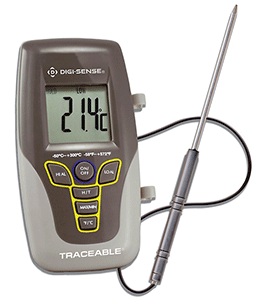Temperature displays, controllers, and meters can be checked for calibration using electrical signals with voltage for thermocouples and resistance for RTDs and thermistors. Electrical simulation is a quick, clean, and inexpensive way to verify their accurate function.
 However, it can provide a false sense of control and accuracy of the temperature process. In nearly all temperature measurements, the probe/sensor being used is the major contributor to the uncertainty or inaccuracy of the measurement. When considering the accuracy of measurements using a temperature display and sensor system, the contribution of the sensor is usually much larger than the display.
However, it can provide a false sense of control and accuracy of the temperature process. In nearly all temperature measurements, the probe/sensor being used is the major contributor to the uncertainty or inaccuracy of the measurement. When considering the accuracy of measurements using a temperature display and sensor system, the contribution of the sensor is usually much larger than the display.
Also, electrical simulation of the temperature display, while convenient, is not sufficient to establish measurement traceability to NIST or otherwise within a measured process.
When the accuracy of your temperature equipment matters, request a full temperature system calibration from your provider.
InnoCal recommends that the probe/sensor and display/meter elements be tested for all temperature systems. This can be done by either testing the probe and meter separately against its own tolerance or as a system. If out-of-tolerance conditions are found, an electrical simulation of the meter or display is appropriate to isolate the issue (which is most often the temperature probe).